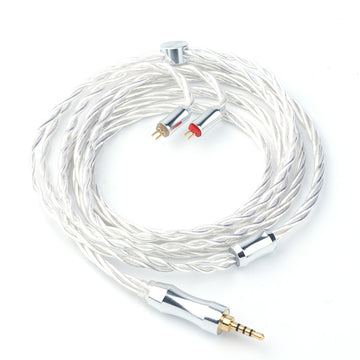Guides
A Short Summary of Planar Magnetic Drivers
by
Kareena Tang
on
Jun 02, 2022
You may have noticed that many excellent planar magnetic driver earphones have emerged recently. Is 2022 the year of Planar IEMs? Are you interested in knowing more about planar magnetic drivers and their mechanism?
Without wasting more time, let's get started and dive right into this short introduction of planar magnetic drivers.
Origin of planar magnetic drivers:
Planar magnetic drivers became more widely recognised after planar magnetic headphones got increasingly popular. The planar magnetic technology was first developed for NASA purposes, and later used in the headphone industry.
Mechanism of planar magnetic drivers:
Planar magnetic headphones produce sounds by regulating the electrical flow through a film that has been suspended between magnets with equal magnetic force. The magnets are placed on either side of the electrically-active diaphragm material. Upon the application of current, this diaphragm gets electrically charged, creating a magnetic field. When the magnets on either side of the diaphragm react with this magnetic field, it causes the diaphragm to move, therefore creating sound waves. Thanks to the isodynamic field, these movements are constant, uninterrupted, and equally distributed across the whole diaphragm, which ensures perfectly balanced sound reproduction.
Advantages and disadvantages of planar magnetic drivers:
Every coin has two sides, just like every item has its pros and cons. While planar magnetic drivers are highly in demand for their excellent sound quality and durability, they are usually heavy and large, and also difficult to drive. Therefore, it poses a unique challenge for audio engineers to create fine planar products with ergonomic design.
Now that you have a better understanding of planar magnetic drivers, here are some suggestions for Planar IEMs and headphones that are available in our store!
|
|
7HZ Timeless $219.99 USD
7HZ Timeless is truly living up to its name with its ultra-thin diaphragm and lightweight body. Everything feels nothing but everything. Time is within reach here. Selected 14.2mm planar driver and unique structure provide fast response, excellent dynamic range and frequency characteristics

|
|
|
RAPTGO HOOK-X $239.00 USD
RAPTGO HOOK-X uses a 14.2mm planar driver, which is driven by powerful N52 magnets. The precision of this driver allows incredibly punchy and impactful sub-bass response, as the ribbon is more responsive to transient signals. Furthermore, the full frequency range is effectively extended from 20Hz to 40kHz to produce an upper treble response previously unobtainable in an IEM.

|
 |
LETSHUOER S12 $169.00 USD
Shuoer has developed a custom 14.8mm large planar magnetic driver for the latest S12 in-ear monitors. It enables the pair to produce exceptional sound performance with powerful lower end, crisp midrange, and detailed treble frequencies. Perfect sound for electronics pops and other genres.It’s a showstopper for your music life.

|
|
|
TINHIFI P1 MAX $169.00 USD
P1 MAX uses 14.2MM planar drive unit, uses a diaphragm of only 2μm thickness, and adopts a double-sided array N52 magnet to generate huge magnetic flux. The "lightweight aluminum diaphragm" reduces the weight of the diaphragm. This combination produces excellent dynamic fast response over a wide frequency range with precise junction positioning and provides excellent audio detail and clarity, suitable for pop vocals, chamber strings, and many other music types.

|
|
|
MUSE HiFi Power $199.00 USD
The latest Muse HiFi power here uses a large 14.5mm planar magnetic driver with a flat diaphragm. The pair here produces a crisp sound performance, all thanks to professional acoustic structure adjustments by the brand. Muse HiFi Power provides an authentic Hi-Res experience.

|
 |
HIFIMAN EDITION XS $499.99 USD
The latest Edition XS uses a newly developed planar magnetic driver with an ultra-thin diaphragm coil known as Neo ultra-thin diaphragm. This driver has an impressively fast response resulting in a highly-detailed sound with lower distortion.

|
 |
GoldPlanar GL2000 $639.00 USD
GL2000 adopts Planar Magnetic Diaphragm Driver. It is designed as a reference tuning headphone, utilizing full frequency adjustment and open back style. The internal driver design was modified from the standard drivers other manufacturers use, with the internal plate having been restructured to increase the surface area and airflow.

|
|
|
GoldPlanar GL1200 $1409.00 USD
The GL1200 is the first True Ribbon headphone from Gold Planar. Highly specialized ribbon drivers are made from aluminium and were developed to reproduce 15Hz to 40kHz bandwidth in order to eliminate the need for sealed chambered bass. In this case, this design allows for open-air baffles (both front and back) for a true full-frequency soundfield.

|


































